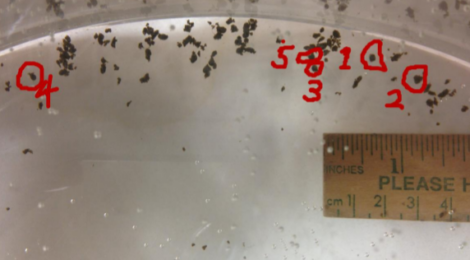
Marine aggregates
Marine aggregates constitute a significant portion of the suspended material in seawater and are highly enriched in bacteria. These include pathogenic bacteria, and aggregates have been shown to harbor Vibrio sp., E. coli, and Enterococcus, among others. Because they provide a favorable micro-habitat for bacteria, understanding the role of aggregates is important to predicting persistence and transport of pathogenic bacteria in aquatic systems. Current experimental work indicates aquatic pathogens may persist significantly longer on aggregates than in the water column, and pathogens in aggregates are likely to accumulate in filter feeding bivalves such as oysters and clams. To try to understand the dynamics of pathogens on aggregates, we consider them as islands of suitable habitat in a hostile matrix subject to a continuous stream of potential bacterial colonists.
We use analytical and simulation models to apply island biogeography theory to bacterial communities on marine aggregates. By combining a mechanistic model of colonization with a stochastic model of population growth and persistence we will develop theoretical predictions of presence and abundance of bacterial species on aggregates. In the model, colonization is limited by the encounter rate, which depends primarily on the concentration of pathogen in the water, the size of the aggregate and the motility of the bacterium. Population growth and persistence are simulated with a stochastic birth-death process and depend strongly on trophic interactions, specifically predation by flagellates, as has been shown experimentally in recent studies. The model provides predictions of equilibrium species richness and the probability of finding pathogens given the size of aggregates and the distance to the source of the pathogen, which will be tested in experimental and field contexts. The result will be improved understanding of bacterial dynamics and disease transmission in marine systems and is timely given that emerging infectious diseases are an increasing problem in ocean health. Our application of dynamical theory places this problem in a larger ecological context, aiding the understanding, forecasting and control of environmentally transmitted pathogens.
Related Publications:.





